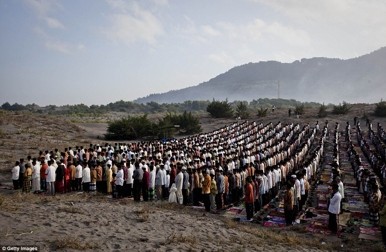Etiquette of Eid
 Eids or festivals are moments of celebration common to all nations. The festivals of non-believing nations are associated with worldly matters such as the birth of a nation or its decline, the appointment or crowning of a ruler, his marriage, or the beginning of a season like spring, and so on. As for Muslims, their festivals (Eids) are associated with their religious rituals. They have only two festivals or Eids: Eid al-Fitr (celebration of the end of Ramadan) and Eid al-Adha (festival of sacrifice).
Eids or festivals are moments of celebration common to all nations. The festivals of non-believing nations are associated with worldly matters such as the birth of a nation or its decline, the appointment or crowning of a ruler, his marriage, or the beginning of a season like spring, and so on. As for Muslims, their festivals (Eids) are associated with their religious rituals. They have only two festivals or Eids: Eid al-Fitr (celebration of the end of Ramadan) and Eid al-Adha (festival of sacrifice).
When the Prophet, sallallaahu ‘alaihi wa sallam, came to Madinah and found the people celebrating two days he said: “What are these occasions”? They said: “We used to celebrate them in Jaahiliyya (before the coming of Islam)”. He, sallallaahu ‘alaihi wa sallam, then said : “Allah has replaced them for you with the two better days (i.e. Eid al-Fitr and Eid al-Adha)”. These two festivals which Allah prescribed to the Muslims are part of the rituals of Islam which should be commemorated and the purposes of which should be understood.
Rules pertaining to Eid:
1. It is forbidden to fast on the day of both Eids, as it is understood from the hadith narrated by Abee Sa’eed that the Prophet, sallallaahu ‘alaihi wa sallam, forbade the fasting of the two Eids.
2. It is recommended that both men and women observe Eid prayer in an open field as is clear in the hadith narrated by Um Atiya, may Allah be please with her, who said: “We used to be ordered to come out on the day of Eid and even to bring the virgin girls from their houses and menstruating women so that they might stand behind the men and say takbir along with them and hope for the blessings of that day for purification from sins”. Since menstruating women (who stay away from the musallah) as well as those who are virgin are commanded to observe Eid prayer, there is no doubt that the men, old and young are even strongly commanded to observe it.
3. Eid prayer should be performed before the khutba of Eid as is confirmed in the hadith narrated by Ibn Amr, Abee Sa’eed, and Ibn Abbas, may Allah be pleased with them.
4. It is recommended that the Imaam makes Takbeer (Allahu Akbar) during the prayer, seven times in the first Raka’at and five in the second. This has been confirmed by the companions of the Salaf (our righteous predecessors).
5. It is recommended that the Imaam recites in the first Raka’at Surah Al-A’alaa (chapter 87) and Surah Al-’Ghaashiah (chapter 88) in the second. Other reports also show that the Prophet, sallallaahu ‘alaihi wa sallam, used to recite Surah Qaaf (chapter 50) and Surah Al-Qamar (chapter 54) as is confirmed in Sahih Muslim.
6. There is no Sunnah prayer either before or after Eid prayer as Ibn Abbas, may Allah, be pleased with him, narrated that whenever the Prophet, sallallaahu ‘alaihi wa sallam, went for Eid prayer, he used to pray two Raka’at (of Eid) but nothing before or after them.
Eid prayer described
Eid prayer is a strongly recommended and important act of worship in Islam and the Prophet, sallallaahu ‘alaihi wa sallam, never neglected it. The Prophet is reported to have ordered men, women and children to proceed to the Eid prayer ground.
Even menstruating women are encouraged to attend the Eid sermon but they should keep away from the prayer area.
It is highly recommended to have ritual ablution (Ghusl) and to wear the most beautiful garments and the best perfumes one possesses.
It (i.e., the Eid Prayer) consists of two Rak’ahs (unit of prayer). Ibn ‘Umar may Allah be pleased with him said: “The journey prayer consists of two Rak’ahs, the Adh-Haa prayer consists of two Rak’ahs, and the Fitr prayer consists of two Rak’ahs as well, and they are complete prayers not shortened according to what the Prophet, sallallaahu ‘alaihi wa sallam, said.”
The first Rak’ah begins with the Takbeer [saying: Allaahu Akbar (Allah is the Greatest)] as the case is in all other prayers. Then Imaam (followed by the praying Muslims) recites seven Takbeeraat (plural of Takbeer). In the second Rak’ah there are five Takbeeraat other than the transmission Takbeer (i.e., the one recited when the Imam and the praying Muslims stand up to perform second Rak’ah). ‘A’ishah, may Allah be pleased with her, said: “The Prophet, sallallaahu ‘alaihi wa sallam, used to recite Takbeer in (the prayers of Eid) Al-Fitr and Al-Adh-Haa, seven Takbeeraat in the first (Raka’ah) and five in the second one other than the two Takbeeraat that precede the Rukoo’ (bowing).”
Imaam Al-Bahawi, may Allah have mercy upon him, said: “This is the opinion of most of the well-versed scholars of the Companions, may Allah be pleased with them all, and those who followed them that there are seven Takbeeraat in the first Rak’ah of the Eid prayer other than the first Takbeer (Takbeeratul Ihram), and five Takbeeraat in the second Rak’ah other than the transmission Takbeer and all before reciting (verses from the Glorious Qur’an). This was narrated from Abu Bakr, ‘Umar, ‘Ali, may Allah be pleased with them, and others.”
When the Prophet, sallallaahu ‘alaihi wa sallam, was done with the Takbeeraat, he used to recite the Faatihah (the first chapter) of the Holy Qur’an) then he recites “Qaaf, By the Glorious Qur’an,” [chapter 50] in the first Rak’ah and Al-Qamar [chapter 54] in the second one.
Sometimes he, sallallaahu ‘alaihi wa sallam, used to recite Al-’Alaa Surah [chapter 87] in the first Rak’ah and Al-Ghashiyah Soorah [chapter 88] in the second one.
The rest of the acts of the Eid prayer are as those of any other prayer; nothing is different.
It is of the Prophetic Sunnah that the Eid sermon should follow the Eid prayer.
Filed in: All











